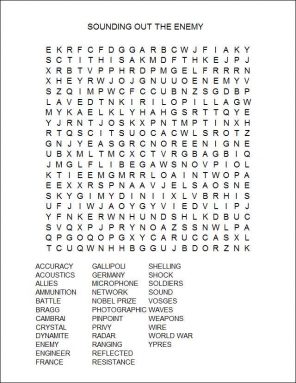Boom! Sounding out the enemy
How the science of acoustics helped end World War I
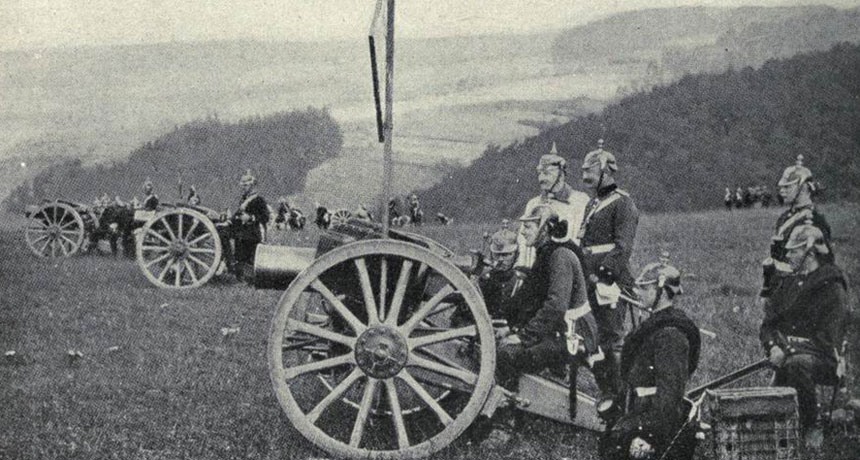
A German howitzer battery in World War I. Finding these guns so that the Allied artillery troops could take them out proved difficult — until some European scientists tapped the science of sound.
Great War Primary Document Archive: Photos of the Great War - www.gwpda.org/photos
By Ron Cowen
After two years of fighting, the British soldiers stationed in France during World War I thought they had seen everything. This was the “Great War.” And it was different than any in the past. For the first time, there were tanks that rolled across farms, through barbed wire and over trenches. Airplanes were providing a new way to spy on the enemy. Poison gas was killing soldiers by the thousands.
But in November 1916, halfway through World War I (WWI), a weapon as new as it was different joined the battle: the microphone.
Sound has been part of war since soldiers started marching to the beat of a drum. But now the science of sound, or acoustics, joined the fight. Listening to the enemy became the latest technological advance.
Acoustics would help battle one of the biggest changes in how war was fought. Before WWI, soldiers fired their weapons out in the open. That means they could be seen. But WWI was fought with longer-range weapons. Firing from far behind the front lines, these guns might be hidden in the thick of forests or behind hills. Unseen by the enemy, they still could strike with deadly accuracy. Finding them would require something equally accurate.
Pinpointing a gun firing from a long distance would prove to be a difficult task. In the end, though, it more than just helped France, the United Kingdom and their Allies win World War I. It also paved the way for other advancements in sound science that would be used on the modern battlefield and even in modern urban cities.
The world at war
World War I, which began in 1914, saw two alliances face one another. On one side were the so-called Central Powers — Germany, Bulgaria and the Ottoman and Austro-Hungarian empires. On the other side were the Allies — France, Great Britain, Russia, Italy and, beginning in 1917, the United States.
New technologies were just one major advance in this Great War. Another was the scale of death. Nine million members of the military and 7 million civilians died in the conflict.To stop the killing, each side sought to destroy the other’s guns. But first, soldiers had to locate those guns.
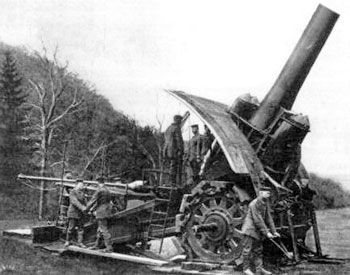
The idea was relatively simple. When a gun fires, the sound travels outward in waves to form an expanding circle. Those waves are similar to the ripples created by a pebble tossed into a pond. A listening array might include three or more microphones, spaced a known distance apart. Each microphone would capture the gun’s boom at different times, depending on its distance from the gun. For example, the microphone closest to the gun would detect its firing first. If the time of arrival of the first sound waves at each microphone could be measured accurately, then the expanding circle of sound waves could be traced out. And that would allow the location of the gun to be determined.
Out of the horse artillery
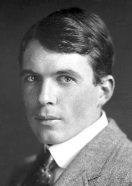
At least that was the theory. Putting it into practice became a year-long challenge for a young British scientist, William Lawrence Bragg. Before the war, he and his father, William Henry Bragg, had used a beam of X-rays to discover the highly ordered arrangement of atoms in a crystal. Those X-rays are type of electromagnetic radiation.
But at the start of World War I, the young Bragg was out of his element. He had been placed in a British regiment that rode horses into battle, even though he knew little about riding.
In July 1915, Hedley pulled Bragg, 25, out of the Royal Horse Artillery. Hedley asked him to work on the sound-ranging project. “To have a job where my science was of use … seemed too good to be true,” Bragg later wrote in his autobiography.
That same summer, he traveled to the Vosges (Vozh) Mountains of France. There, the scientist examined first-hand the experimental sound-ranging equipment developed by the French. While in France, Bragg also learned that his younger brother, Bob, had died of wounds suffered during combat in Gallipoli (Guh-LIP-oh-lee), Turkey.
Still in mourning, Bragg went to Paris to gather electrical supplies for the first sound-ranging station. It would be set up at Kemmel Hill, south of the village of Ypres (EE-pruh), in neighboring Belgium. That area would see some of the worst fighting in this war.
How sound ranging worked
To accurately record the time it took for a gun’s boom to reach each microphone, Bragg and his colleagues decided to use a technique developed by Lucien Bull. This Irish-born physicist worked at the Institute Marey in Paris. Bull’s method relied on the laws of physics that govern electricity and magnetism. When electric current flows through a wire placed in a magnetic field, the wire experiences a magnetic force. The wire then starts to move.
In Bull’s setup, each microphone was connected to a separate electrical wire. Each of those wires in turn fed into a box that included a powerful magnet. When a microphone detected a sound wave, it sent current through its wire. That current caused the wire to jump. Each wire jumped at a different time. (Again, this depended on the microphone’s distance from the source of the gunfire.) The various motions caused individual spikes. These were recorded on a moving strip of photographic film placed inside the box. The distance between the spikes on the film accurately reflected the differences in arrival time of the gun’s sound waves at each microphone.
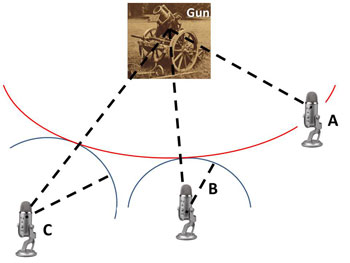
In early November, Bragg received some good news. A telegram informed him that he and his father had just won the Nobel Prize in physics. That wasn’t the only reason to celebrate, though. After months of experimenting, Bragg’s team had finally located their first enemy gun.
That success helped sound ranging overcome the skepticism of British military officials. Now it could become a major player in defeating the Central Powers. World War I became the “acoustic war,” says Daniel Kevles. A science historian, he works at Yale University in New Haven, Conn.
Tough problems demanded sound solutions
Still, the sound ranging method was far from perfect. Weather was one challenge. If the wind blew toward the microphones, the sound waves tended to rise upward. That meant the sound waves would miss the recording instruments altogether.
But there was a more serious problem, as well. Sometimes, an enemy shell would travel through the air faster than sound. Just as an airplane doing so will create a sonic boom, so too will a shell if it reaches a supersonic velocity. The interaction of the shell with the air directly over a listener’s head generates that shock. This sound provides no useful information on the gun’s location. Worse yet, the microphones Bragg used could not tell the difference between the useless shock wave of the shell and the sound wave generated by the gun.
What’s more, the gun’s sound wave vibrated at a much lower frequency — about 10 times a second — than the shock wave’s loud crack. This made the dull, low sound from the gun difficult to hear. It also proved difficult to detect with the microphones that were then available to Bragg’s team.
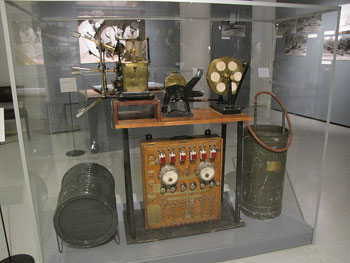
Soon after, Corporal William Tucker, a physicist from Imperial College, London, had another insight. He was resting on a bed inside a hut covered in tarpaper. (This waterproof material is made of stiff paper coated in tar.) Through holes in the tarpaper wall, a cold puff of air sometimes struck his face. The cool blast, he eventually realized, wasn’t the wind. Instead, it marked the change in air pressure that accompanied each barely audible sound wave from guns firing nearby.
Detecting that change in air pressure required some clever engineering, though. Tucker and Bragg knew that in cooler temperatures, electrical wires have less resistance to electric current. That means current flows more easily. The two scientists took advantage of that property to detect the cooling blast of the gun wave.
First, Tucker and Bragg inserted a wire through a hole in an empty ammunitions box or other container. After they stretched and heated that wire, they waited. When a gun’s sound wave passed through the hole, it cooled the wire. More current flowed. In contrast, the passage of the shock wave — useless to Bragg’s team — did not change the temperature of the wire. Nor did it alter the flow of current.
New microphone systems took advantage of the gun wave’s cooling effect. By September 1916 they were in place .
William Van der Kloot is a World War I expert, now retired from the State University of Stony Brook in New York. He has studied those sound systems. Typically, a sound-ranging unit had two microphone stations and two observation posts, Van der Kloot says. Every unit required some 24 kilometers (15 miles) of high-quality, low-resistance wire.
The Germans also experimented with sound ranging. But they never perfected the technique. The Allies carefully guarded the secret technology. British soldiers stationed near the equipment carried dynamite. One of their tasks: Blow up the instruments if it seemed the valuable technology was at risk of falling into enemy hands.
A sound victory
Shelling frequently severed the networks of wires. Sound rangers regularly risked their lives to repair them, Bragg later recalled. When the United States entered the war in the spring of 1917, “American commanders came to regard [rangers] as indispensable,” noted science historian Kevles at a 2015 meeting of the American Astronomical Society in Seattle, Wash. He spoke during a session looking at the war’s impact on astronomy and other sciences.
The sound rangers were credited with rooting out enemy guns in the British victory at Cambrai (Kam-bray), France, on November 20, 1917. In London, church bells rang to celebrate the quick destruction of the German artillery. Sound ranging also played a major role during the war’s final battle at Amiens (AH-mee-aahn) in 1918.
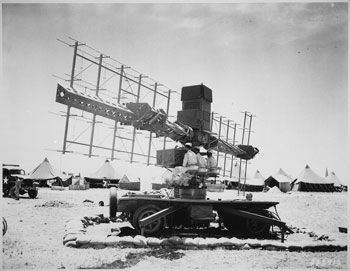
Radio waves are another type of electromagnetic radiation. The reflected radio waves reveal the location of enemy craft. Since radar was first developed, it has spread beyond the world of warfare into fields such as meteorology, where it is used to track weather.
More recently, the militaries in several countries, including the United States, the Netherlands, Singapore and India, have become interested in a miniature sound sensor. It listens to the motion of air particles. This device then measures how the particles are disturbed by sound waves. A computer determines where the sound is coming from. It also filters out engine, environmental and other sounds that aren’t of interest.
In their own words
Listen to audio recordings of World War I soldiers’ memories.
When mounted on airplanes, helicopters, drones or soldiers, the detectors rapidly sense the motion of air particles caused by enemy fire. That allows these craft or soldiers to return fire before the enemy relocates or reloads.
Sound ranging is also playing a role in civilian life. Over the past decade, a program called ShotSpotter has placed sensitive microphones in several cities, including Washington, D.C., and New York City.
These sensors can tell the difference between sounds that are explosive in nature, such as bursts of gunfire, and background noise. Individual sensors record the distance to the gunfire; a network of several sensors then pinpoints the location of the gunfire. The method is similar to that used by the much simpler microphones of WWI. That gunshot information is then relayed to the police. This instantly points them to violence they might not otherwise have known about.
These modern sensors, which use digital electronics, are light-years ahead of the ones used in battle a century ago. But perhaps the best sound of all was the one recorded by those early sound-ranging microphones in France on the 11th hour of the 11th day of the 11th month of 1918: silence. That’s when World War I officially ended — a day we now know as Veterans Day (formerly Armistice Day).

Power Words
(for more about Power Words, click here)
acoustics The science related to sounds and hearing.
armistice A ceasefire or truce. Armistice Day was the name given to the holiday celebrating the end of World War I.
array A broad and organized group of objects. Sometimes they are instruments placed in a systematic fashion to collect information in a coordinated way. Other times, an array can refer to things that are laid out or displayed in a way that can make a broad range of related things, such as colors, visible at once.
artillery Large caliber land-based guns used in fighting wars; or the military crews assigned to fire these weapons.
astronomy The area of science that deals with celestial objects, space and the physical universe as a whole. People who work in this field are called astronomers.
atom The basic unit of a chemical element. Atoms are made up of a dense nucleus that contains positively charged protons and neutrally charged neutrons. The nucleus is orbited by a cloud of negatively charged electrons.
crater A large, bowl-shaped cavity in the ground or on the surface of a planet or the moon. They are typically caused by an explosion or the impact of a meteorite or other celestial body.
crystal A solid consisting of a symmetrical, ordered, three-dimensional arrangement of atoms or molecules. It’s the organized structure taken by most minerals. Apatite, for example, forms six-sided crystals. The mineral crystals that make up rock are usually too small to be seen with the unaided eye.
current A fluid body — such as of water or air — that moves in a recognizable direction. (in electricity) The flow of electricity or the amount of electricity moving through some point over a particular period of time.
drone A pilotless aircraft or missile flown autonomously or by remote control.
dynamite A type of explosive.
electric current A flow of charge, called electricity, usually from the movement of negatively charged particles, called electrons.
electric field A region around a charged particle or object within which a force would be exerted on other charged particles or objects.
electricity A flow of charge, usually from the movement of negatively charged particles, called electrons.
electromagnetic radiation Energy that travels as a wave, including forms of light. Electromagnetic radiation is typically classified by its wavelength. The spectrum of electromagnetic radiation ranges from radio waves to gamma rays. It also includes microwaves and visible light.
engineer A person who uses science to solve problems. As a verb, to engineer means to design a device, material or process that will solve some problem or unmet need.
force Some outside influence that can change the motion of a body, hold bodies close to one another, or produce motion or stress in a stationary body.
frequency The number of times a specified periodic phenomenon occurs within a specified time interval. (In physics) The number of wavelengths that occurs over a particular interval of time.
magnet A material that usually contains iron and whose atoms are arranged so they attract certain metals.
meteorology (adj. meteorological) The study of weather as it pertains to future projects or an understanding of long-term trends (climate). People who work in this field are called meteorologists.
particle A minute amount of something.
physics The scientific study of the nature and properties of matter and energy. Classical physics is an explanation of the nature and properties of matter and energy that relies on descriptions such as Newton’s laws of motion. It’s an alternative to quantum physics in explaining the motions and behavior of matter. A scientist who works in that field is known as a physicist.
pressure Force applied uniformly over a surface, measured as force per unit of area.
privy A primitive toilet, sometimes no more than shed covering a board (used as a seat) across a hole dug in the ground.
radar A system for calculating the position, distance or other important characteristic of a distant object. It works by sending out periodic radio waves that bounce off of the object and then measuring how long it takes that bounced signal to return. Radar can detect moving objects, like airplanes. It also can be used to map the shape of land — even land covered by ice.
radio To send and receive radio waves; or the device that receives these transmissions.
range The full extent or distribution of something. For instance, a plant or animal’s range is the area over which it naturally exists. (in math or for measurements) The extent to which variation in values is possible. Also, the distance within which something can be reached or perceived.
sensor A device that picks up information on physical or chemical conditions — such as temperature, barometric pressure, salinity, humidity, pH, light intensity or radiation — and stores or broadcasts that information. Scientists and engineers often rely on sensors to inform them of conditions that may change over time or that exist far from where a researcher can measure them directly.
sonic Of or relating to sound.
sound wave A wave that transmits sound. Sound waves have alternating swaths of high and low pressure.
supersonic Moving at somewhere between one and five times the speed of sound in air.
technology The application of scientific knowledge for practical purposes, especially in industry — or the devices, processes and systems that result from those efforts.
velocity The speed of something in a given direction.
wave A disturbance or variation that travels through space and matter in a regular, oscillating fashion.
World War I Also known as WWI and the Great War. This war began in 1914, as two alliances faced off against one another. On one side were the so-called Central Powers — Germany, Bulgaria and the Ottoman and Austro-Hungarian empires. On the other side were the Allies — France, Great Britain, Russia, Italy and, beginning in 1917, the United States.
X-ray A type of radiation analogous to gamma rays, but of somewhat lower energy.
Word Find (click here to enlarge for printing)
